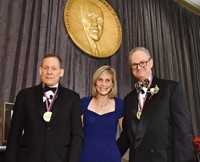Advertisement
Grab your lab coat. Let's get started
Welcome!
Welcome!
Create an account below to get 6 C&EN articles per month, receive newsletters and more - all free.
It seems this is your first time logging in online. Please enter the following information to continue.
As an ACS member you automatically get access to this site. All we need is few more details to create your reading experience.
Not you? Sign in with a different account.
Not you? Sign in with a different account.
ERROR 1
ERROR 1
ERROR 2
ERROR 2
ERROR 2
ERROR 2
ERROR 2
Password and Confirm password must match.
If you have an ACS member number, please enter it here so we can link this account to your membership. (optional)
ERROR 2
ACS values your privacy. By submitting your information, you are gaining access to C&EN and subscribing to our weekly newsletter. We use the information you provide to make your reading experience better, and we will never sell your data to third party members.
Awards
Paul Alivisatos named 2021 Priestley Medalist
UC Berkeley researcher honored for pioneering work in nanomaterials and service to the science community
by Mitch Jacoby
June 25, 2020
| A version of this story appeared in
Volume 98, Issue 25

The old adage “If you want something done, ask a busy person to do it,” aptly describes A. Paul Alivisatos.
The University of California, Berkeley, scientist is the Samsung Distinguished Professor of Nanoscience and Nanotechnology and a professor of chemistry and materials science and engineering, as well as the university’s executive vice chancellor and provost. He is also director emeritus of Lawrence Berkeley National Laboratory and the founding editor in chief of Nano Letters, published by the American Chemical Society.
Now he can add ACS’s highest honor to his resume. For “foundational contributions to the chemistry of nanoscience, development of nanocrystals as nanotechnology building blocks, and leadership in the chemistry and nanoscience communities,” Alivisatos will receive the 2021 Priestley Medal.
Since the early 1990s, Alivisatos has explored the chemical and physical properties of nanosized bits of matter—often colloidal semiconductor nanocrystals—and developed widely used methods for controlling them. He and his coworkers demonstrated that these crystals can be grown with precision in a large number of shapes and morphologies, modified systematically, and assembled into functional materials.
In one seminal study, Alivisatos’s group showed that these crystals could be used as highly fluorescent probes for biological staining and diagnostics. Those findings led Alivisatos and coworkers to found Quantum Dot Corporation (now a brand under Fisher Scientific) to sell nanocrystal products worldwide to biomedical research groups and hospital pathology laboratories for analyzing tumors.

The Berkeley researcher also demonstrated that by tailoring the emission properties of semiconductor nanocrystals via chemical means, the products could be used in light-emitting diodes and solar cells. Now the materials are used commercially in high-end electronic displays and quantum-dot televisions.
Alivisatos hasn’t just created new materials. He and his colleagues have also come up with novel ways of analyzing them. For example, his team developed an angstrom-resolution microscopy method for tracking the growth of nanocrystals by confining droplets of precursors in graphene bubbles. They also came up with a way to image angstrom-sized particles as they drift and rotate freely in solution.
“This is wonderful news,” says Georgia Institute of Technology’s Mostafa A. El-Sayed, a nanoscience researcher. “Paul’s publications have led to fundamental understanding and chemical tools that are used by thousands of researchers worldwide. His discoveries benefit human health, improve electronic technology, and promote energy efficiency.”
Reflecting on Alivisatos’s numerous professional roles, University of Oregon’s Geraldine L. Richmond remarks “it is rare for an actively practicing scientist of such continued high accomplishment to also be involved at this level of impact in the service of the science community and humanity.”
“This is a huge honor and I’m very grateful,” Alivisatos says. He is quick to point out that he didn’t achieve these accomplishments alone. His coworkers deserve much of the credit, he says. “I am very fortunate to work with a wonderful group of inventive, creative colleagues. I feel very privileged to work with them.”
UPDATE
This story was updated on June 25, 2020, to clarify that Quantum Dot Corporation is now a brand sold under Fisher Scientific. Quantum Dot is no longer a stand-alone company.





Join the conversation
Contact the reporter
Submit a Letter to the Editor for publication
Engage with us on Twitter